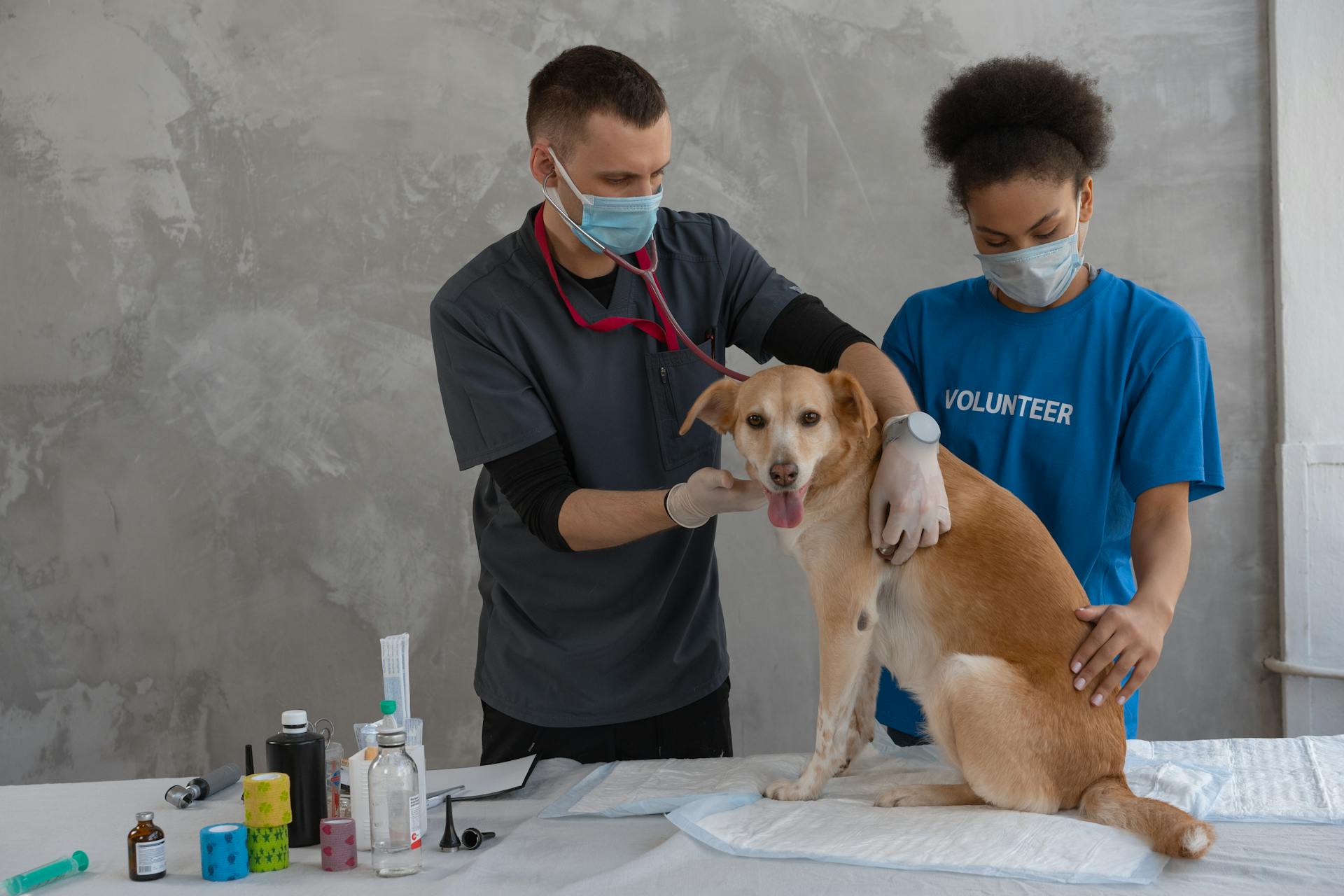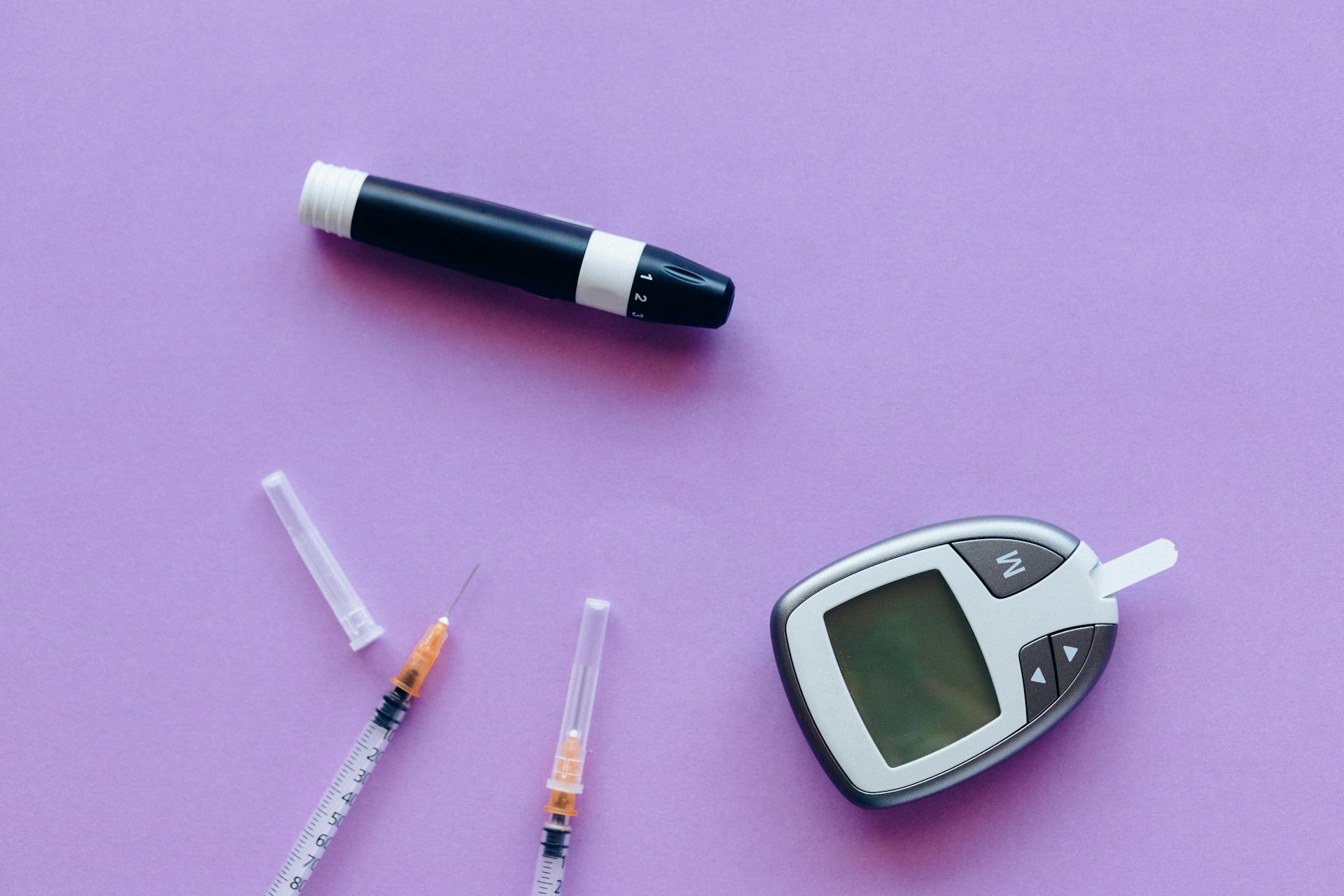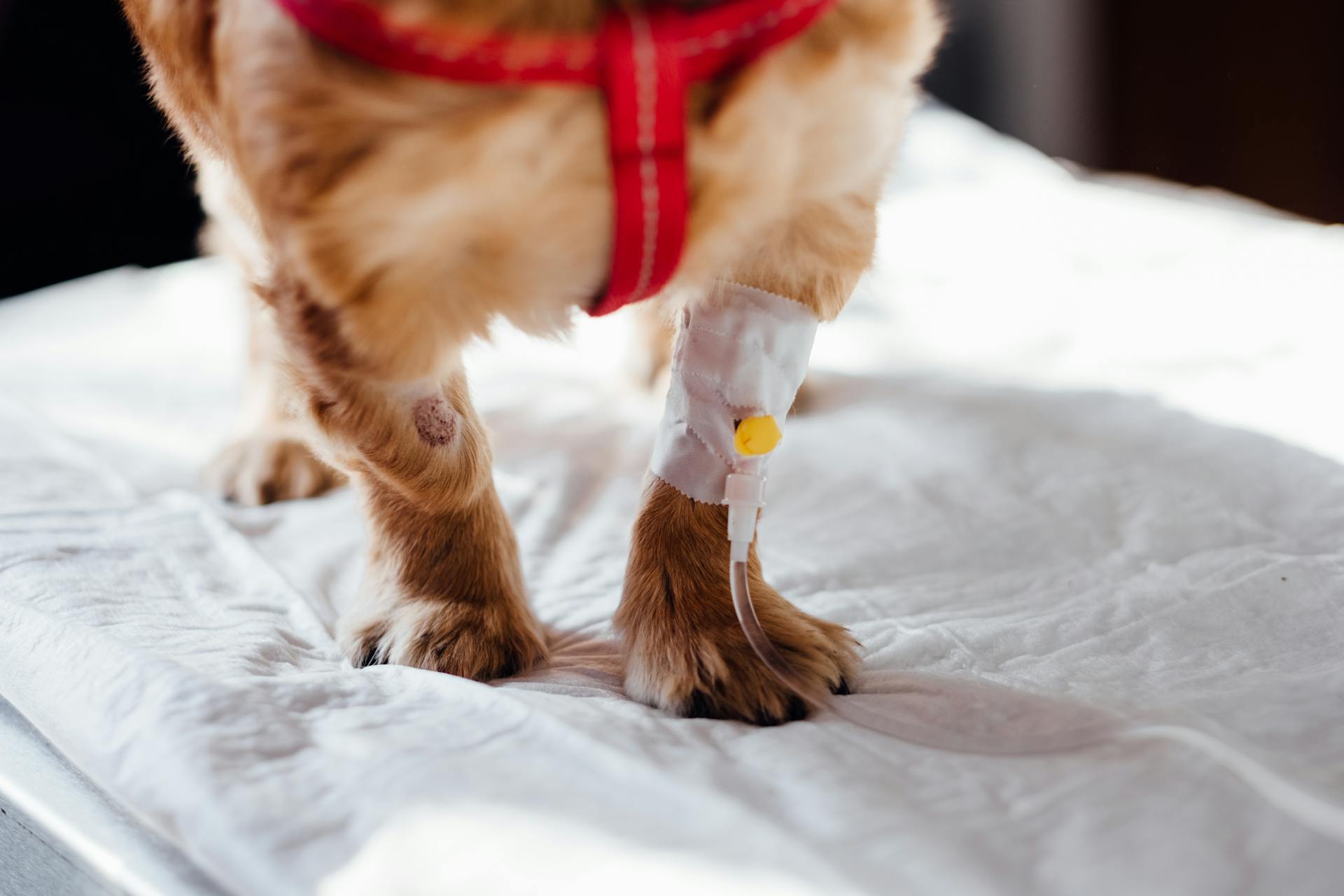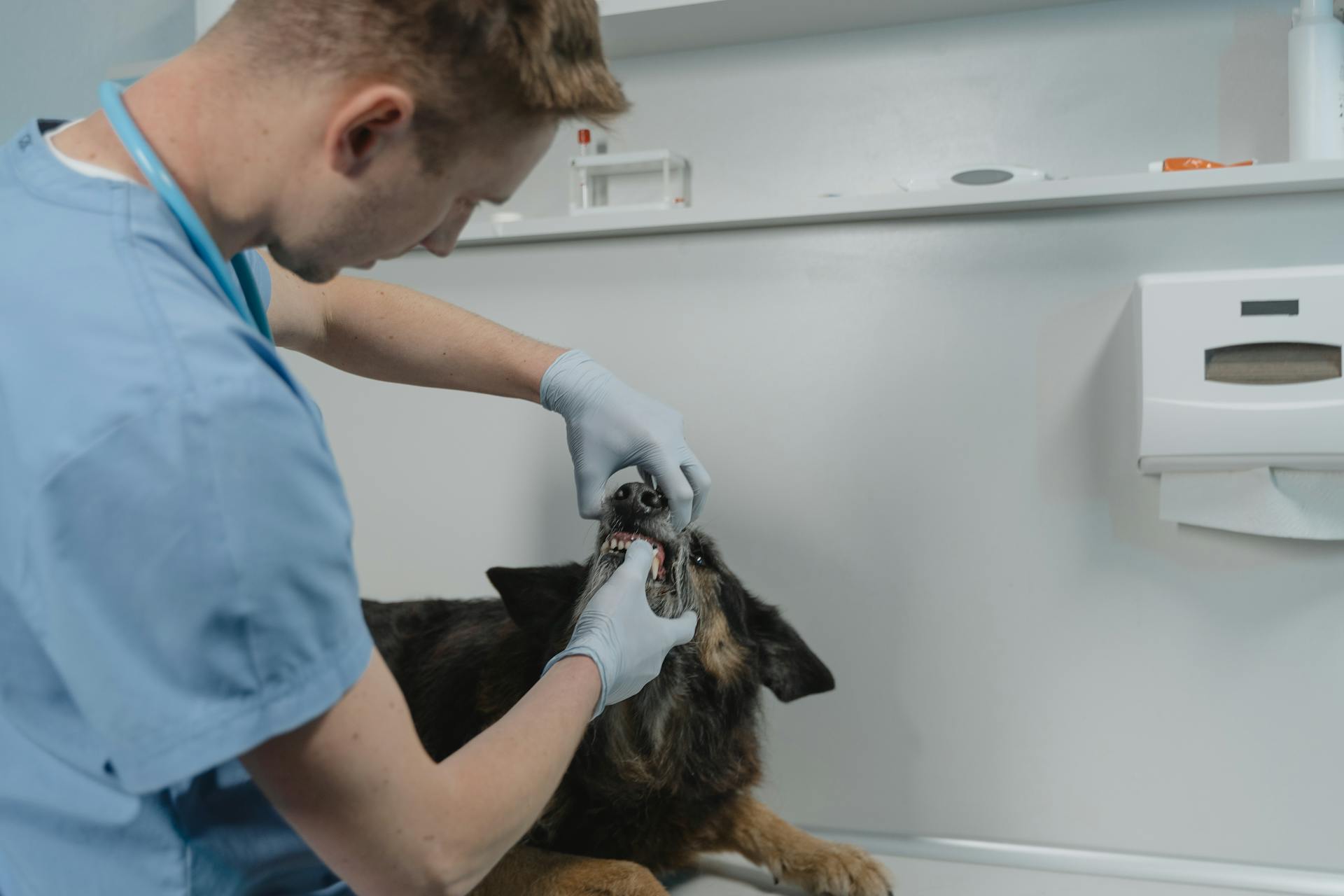
Diabetes in dogs is a common endocrine disorder that affects millions of canine companions worldwide. It occurs when the pancreas fails to produce enough insulin, a hormone that regulates blood sugar levels.
Genetics play a significant role in the development of diabetes in dogs, with certain breeds being more prone to the condition. For example, the Poodle, Rottweiler, and Cocker Spaniel are among the breeds most commonly affected.
Obesity is another major risk factor for diabetes in dogs, as excess weight puts additional strain on the pancreas. A study found that dogs with a body condition score of 6 or higher are more likely to develop insulin resistance and diabetes.
Age is also a significant factor, with middle-aged to older dogs being more susceptible to diabetes.
On a similar theme: What Breeds of Dogs Are Prone to Deafness
What Causes Diabetes in Dogs
Diabetes in dogs can be caused by a variety of factors, but most dogs acquire Type I, or insulin-dependent diabetes.
The immune system mistakenly attacking insulin-producing cells in the pancreas is the likely cause of Type I diabetes, leading to a total or partial loss of insulin secretion.
Females are more prone to diabetes than males.
Middle-aged to senior dogs have a higher risk of developing diabetes.
Obesity is also a significant risk factor for diabetes in dogs.
Some dog breeds are more susceptible to diabetes, including the Alaskan Malamute, Australian Terrier, Bichon Frise, Cairn Terrier, Keeshond, Labrador Retriever, Miniature Schnauzer, Miniature Dachshund, Norwegian Elkhound, Poodle, Pug, Samoyed, Tibetan Terrier, and Yorkshire Terrier.
Here's a list of dog breeds that are predisposed to diabetes:
- Alaskan Malamute
- Australian Terrier
- Bichon Frise
- Cairn Terrier
- Keeshond
- Labrador Retriever
- Miniature Schnauzer
- Miniature Dachshund
- Norwegian Elkhound
- Poodle
- Pug
- Samoyed
- Tibetan Terrier
- Yorkshire Terrier
Symptoms and Diagnosis
If your dog is showing signs of diabetes, you'll want to know what to look out for. Increased thirst and urination are two of the most common symptoms of diabetes in dogs.
Here are some other symptoms to watch out for: Increased appetiteWeight lossLethargyDehydrationCataracts
If you suspect your dog has diabetes, it's essential to get them to the vet as soon as possible. A veterinarian may diagnose diabetes based on physical exam findings and symptoms shown at home, but they'll also need to run some tests to confirm the diagnosis. Some of these tests include blood chemistry and complete blood count (CBC), urinalysis, and fructosamine.
Symptoms

If your dog is showing signs of diabetes, it's essential to recognize the symptoms early on. Increased thirst is one of the most common signs, as dogs with diabetes produce more urine and need to drink more water to compensate.
Dogs with diabetes may also urinate more frequently, sometimes even in the house if they can't get outside in time. This is because their bodies are producing more urine due to high blood sugar levels.
Another common symptom is increased appetite, as dogs with diabetes may be hungrier due to their bodies breaking down fat for energy. This can lead to weight loss, even if your dog is eating more.
Lethargy is also a common symptom, as dogs with diabetes may feel weak and tired due to high blood sugar levels. Dehydration can also occur, as dogs with diabetes may not be able to regulate their water intake properly.
Cataracts can also be a sign of diabetes in dogs, particularly if left untreated.
Here are the common symptoms of diabetes in dogs:
- Increased thirst
- Increased urination
- Increased appetite
- Weight loss
- Lethargy
- Dehydration
- Cataracts
Diagnosis and Treatment

Diagnosis of diabetes in pets typically begins with a veterinarian suspecting the condition based on physical exam findings and symptoms shown at home. Your veterinarian may recommend a panel of blood and urine tests, including urine bacterial culture, to confirm any suspicions and rule out other diseases.
A key indicator of diabetes is consistently high amounts of glucose in the blood and urine. Your veterinarian will also assess your pet's weight, appetite, drinking, and urination to determine the best course of action.
To officially diagnose diabetes, veterinarians must find persistent high blood and urine glucose values. This may involve a range of tests, including blood chemistry and complete blood count (CBC), urinalysis, and fructosamine.
Your veterinarian may also recommend additional tests, such as radiography, thyroid tests, Cushing's testing, abdominal ultrasonography, and pancreatitis blood testing, to rule out other potential causes of your pet's symptoms.
Here are some common tests used to diagnose diabetes in dogs:
- Blood chemistry and complete blood count (CBC)
- Urinalysis
- Fructosamine
- Radiography
- Thyroid tests
- Cushing’s testing
- Abdominal ultrasonography
- Pancreatitis blood testing
Once diabetes is diagnosed, your veterinarian will work with you to develop a treatment plan that may include insulin injections, dietary therapy, and regular monitoring of your pet's blood sugar levels.
Diagnosis in Cats

In cats, stress-induced hyperglycemia is a common problem, which can make it tricky to diagnose diabetes mellitus.
A normal blood glucose concentration in cats is between 75–120 mg/dL, measured after food withholding. This is an important benchmark to determine if a cat's blood glucose levels are elevated.
Multiple blood and urine samples may be required to confirm a diagnosis of diabetes mellitus in cats, due to the prevalence of stress-induced hyperglycemia.
Measurement of serum fructosamine concentration can assist in differentiating between stress-induced hyperglycemia and diabetes mellitus. In cases of stress-induced hyperglycemia, the fructosamine concentrations are normal.
A thorough history should be taken to rule out exposure to drugs or diseases that predispose to diabetes. This is crucial to ensure an accurate diagnosis and effective treatment plan.
Explore further: Dogs Not Eating but Acting Normal
Ketones – Ketoacidosis
Ketones – Ketoacidosis is a serious condition that can arise in people with diabetes. It's caused by high blood sugar levels and low insulin levels, combined with certain other stresses.
A fresh viewpoint: Blood Sugar Levels for Dogs with Diabetes
High blood sugar levels can trigger ketone production, and you need to monitor your ketone levels if your blood sugar is over 14 mmol/L or 250 mg/dL. Dehydration can also cause ketones to build up in the body.
If you're not eating for over 12 hours, you're more likely to develop ketones. Vomiting, lethargy, and infection or illness can also contribute to ketone production. High stress levels can also trigger ketones.
A breath that smells like acetone or nail-polish remover can be a sign of ketones. If your skin doesn't snap back into place quickly after being gently pinched, or if your gums are tacky or dry, you may have ketones.
Ketones are produced by the liver as part of fat metabolism, but they're normally not found in sufficient quantity to be measured in the urine or blood of non-diabetics or well-controlled diabetics. If you're testing for ketones, make sure to use fresh urine – ketones evaporate quickly, and you may get a false negative result if testing older urine.
The urine testing strip bottle has instructions and color charts to help you read the results. You need to read the colors at the correct time – in 15 or 30 seconds – to get an accurate result.
Readers also liked: Yorkshire Terrier Not Eating
Managing Diabetes in Dogs
Managing diabetes in dogs requires a lifelong commitment to monitoring and treatment. Dogs with diabetes need insulin and diet control for life, with frequent vet visits to determine the best insulin dose for treatment.
To manage your dog's diabetes, maintain their medication and feeding schedules as recommended by your veterinarian. Ensure your dog eats normally while receiving insulin or an SGLT2 inhibitor to avoid hypoglycemia.
Monitoring your dog's blood and urine glucose levels, as well as urine ketone levels if they're on an SGLT2 inhibitor, is crucial. Watch for signs of hypoglycemia, such as weakness, tremors, seizures, and uncoordinated movements, and contact your veterinarian immediately if you notice any of these symptoms.
Here are some common ways to monitor a dog's response to insulin treatment:
- Blood glucose curve: the most accurate way to monitor your dog's blood sugar, with blood drawn every one to two hours.
- Freestyle Libre: a painless sensor on your dog's skin to measure blood glucose, useful for anxious or uncooperative dogs.
- Fructosamine: a general indicator of glucose regulation over two to three weeks, useful as a chronic monitoring tool.
- Urine glucose and ketone measurements: an easy and inexpensive way to monitor dogs at home, using a small strip in the urine stream.
Recovery and Management
Dogs with diabetes require lifelong monitoring and treatment. Insulin and diet control are typically needed for life.
Initially after diagnosis, your dog may need frequent vet visits to help your vet determine the best insulin dose for treatment to control your pet's blood sugar.
Additional reading: Veteran Dog Treats
Blood glucose curve is usually the most accurate way to monitor your dog's blood sugar. Your dog will stay at the veterinary hospital all day, having blood drawn every one to two hours.
There are four main ways to monitor a dog's response to insulin treatment:
- Blood glucose curve
- Freestyle Libre
- Fructosamine
- Urine glucose and ketone measurements
Management goals for pups include reducing symptoms, maintaining a healthy blood-glucose level, and improving quality of life.
Therapeutic goals for diabetes in dogs are different from those in humans. Veterinarians do not control animals' glucose as tightly as humans.
Never adjust your pet's insulin without the direction and supervision of your veterinarian.
If your dog is not eating or they're vomiting, call your vet to determine if you should give their insulin. If they are experiencing any signs of low blood sugar, such as weakness, "star-gazing", or tremors/seizures, they should be seen by their vet or an emergency vet immediately.
Check this out: My Dogs Not Eating and Is Lethargic
Treatment
Managing diabetes in dogs requires a combination of insulin, dietary management, and lifestyle changes. Insulin injections are a crucial part of treatment, and your veterinarian will prescribe an initial dose and type of insulin that best suits your dog's individual needs.
Insulin injections usually need to be given twice a day to keep blood glucose levels under control. The dose and timing of the injections may need a few adjustments at first, depending on how your dog responds.
Dietary therapy centers on helping obese pets lose weight, and stopping diabetes-associated weight loss in others, while providing suitable amounts of protein and carbohydrates. Regular exercise may be prescribed, too, based on your dog's age, weight, and overall health.
Frequent monitoring is essential to ensure your dog's diabetes is well controlled. This can be done at home using a variety of methods, including blood glucose curves, Freestyle Libre, fructosamine, and urine glucose and ketone measurements.
If your dog is showing signs of hypoglycemia, such as weakness, "star-gazing", or tremors/seizures, they should be seen by their vet or an emergency vet immediately. In this case, a sugar solution should be poured on the finger and rubbed on their gums or under their tongue (sublingually).
Here are some tips for managing hypoglycemia:
- Offer food at the first signs of possible hypoglycemia
- Use a sugar solution, such as corn syrup or honey, rubbed onto the gums or under the tongue
- Feed a small meal and take your dog for medical evaluation to determine if further treatment is needed
Remember, managing diabetes in dogs requires patience, understanding, and cooperation from both you and your veterinarian. With the right treatment and lifestyle changes, your dog can live a happy and healthy life.
Treatment and Care
Diagnosing diabetes in dogs is just the first step. Your veterinarian may suspect diabetes based on your dog's signs, but a panel of blood and urine tests, including urine bacterial culture, is needed to confirm the diagnosis.
Dogs with diabetes require lifelong treatment, which means regular monitoring, medication, and lifestyle changes. This can be challenging, but with the right approach, many dogs can live happy and healthy lives.
The key to managing diabetic dogs is to keep their blood glucose levels near normal. This can be achieved through a combination of insulin injections, dietary therapy, and regular exercise. Your veterinarian will prescribe an initial dose and type of insulin, and teach you how to give insulin injections, which are generally well-tolerated by dogs.
Dietary therapy centers on helping obese dogs lose weight, while providing suitable amounts of protein and carbohydrates. Regular exercise may also be prescribed, based on your dog's age, weight, and overall health.
You might like: Sudden Weight Gain in Female Dog
To give your dog their best chance at success, it's essential to maintain their medication and feeding schedules as recommended by your veterinarian. This includes monitoring their blood and urine glucose levels, and watching for signs of complications, such as hypoglycemia, cataracts, and urinary tract infections.
Here are some signs to watch out for:
- Weakness or lethargy
- Tremors
- Seizures
- Uncoordinated movements or walking strangely
If you observe any of these signs, contact your veterinarian or an emergency clinic immediately.
In addition to medication and dietary changes, lifestyle management can also play a crucial role in preventing diabetes attacks. Regular physical exercise, such as walking or swimming, can help preserve tissue and prevent complications.
Frequently Asked Questions
How can I prevent my dog from getting diabetes?
Preventing dog diabetes involves maintaining a healthy weight through a balanced diet and regular exercise, as well as monitoring for signs of the condition
Sources
- https://www.avma.org/resources-tools/pet-owners/petcare/diabetes-pets
- https://www.petmd.com/dog/conditions/endocrine/diabetes-dogs
- https://vcahospitals.com/know-your-pet/diabetes-mellitus-in-dogs-overview
- https://www.merckvetmanual.com/endocrine-system/the-pancreas/diabetes-mellitus-in-dogs-and-cats
- https://en.wikipedia.org/wiki/Diabetes_in_dogs
Featured Images: pexels.com


